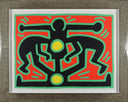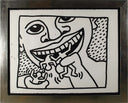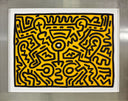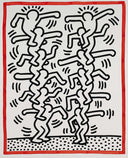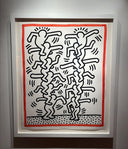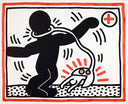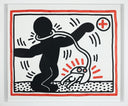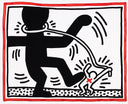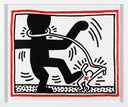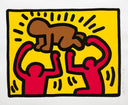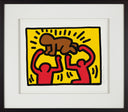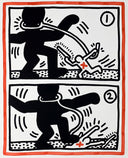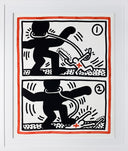Growing, 1988 #2
Details
Year: 1988
Edition: 192
Sheet size: 30 x 40"
Image size: 30 x 40"
Framed size: 39 x 49"
Signature: signed and dated 'K. Haring 88' lower right
About the Work
"Growing #2" is a unique trial-proof screenprint created by Keith Haring in 1988 for his 'Growing' series. From the edition of 192, the unique trial-proof is signed and dated 'K. Haring 88' lower right. The image size is 30 x 40" and the artwork is framed in a custom, closed-corner, gold leaf frame. The artwork ships framed and accompanied by a certificate of authenticity.
Dubbed “a child of Pop Art,” Keith Haring swiftly ascended to be among the genre’s royalty when his career soared in the 1980s. With iconic line-work and bold colors, Haring seamlessly embraced tropes of commercial culture while creating a wholly unique body of work that pushed against the status quo. As Haring wove together high and low, so too did his subject matter ricochet between tragedy (including the AIDS crisis and South African apartheid) and pure, infectious joy of being. The 1988 Growing Suite exemplifies the latter — the series bursts with vibrant color and bodies-in-motion, a style that is pure Haring and an homage to 1980s dance styles – electric boogie, break-dancing, and vogueing, to name a few.
“Because the hand is central to Keith’s process,” Jeffrey Deitch says, “his work comes right out of his body.” This notion of Haring’s prints as a mobile extension of the artist’s body emanates from the Growing Suite, both in its ecstatic, interconnected content and the chosen medium of screen printing. In subject, the works bear similarity to the Pop Shop I and Pop Shop II series of that same era; all three series feature Haring’s iconic human figures in various stages of movement and convergence. As its title suggests, Growing’s forms are transitory, in-process, and, significantly, interdependent. Circles appear (often interchangeably) as heads and abdomens within the series, suggesting seeds and sources of origin. In one work, a single figure branches upward and outward into multiple figures like a tree growing towards the sun. That upward thrust appears again in the “people ladder,” where a smaller, child-like figure appears lifted into being by two supporting figures.
That Haring so readily adapted his inherently intimate medium — drawing — for purposes of reproduction is integral to his particular genius and legacy. “Whatever [Haring] carried out, he tended towards swift dissemination, duplication and ubiquitous application,” Werner Jehle wrote in his introduction to Keith Haring: Editions on Paper 1982-1990. While such “ubiquity” may for some preclude Haring from an academicized art historical canon, it is arguably his embrace of an inclusive, pluralistic vision of humanity that imbues his work with so much power. Deitch nods to Haring’s deliberate universality, offering “[Haring] is one of the primary links between hip hop from the South Bronx, gay dance club culture, the conceptual art culture of the Lower East Side, and street art culture. He put all these things together. In his lifestyle and his circle, and, obviously, in his art.” As a microcosm of Haring’s career and life, Growing expresses Haring’s belief in the power of collective action and the interconnectedness of humanity. The figures’ simplified forms, rendered without hierarchy, have an archetypal quality that feels as fresh today as it did when first created.
Haring’s regular editions are desirable in their own right, as in Growing #1 above, the most popular image in the series. However, two of these particular prints are unique trial-proof screenprints. Growing #2 and #3 feature experimental combinations of color — subtle variation in #3 and bold departure in #2. Unlike the regular edition prints, each trial proof is one of a kind, effectively blurring the line between printmaking and unique work. Collectors prize trial proofs for exactly this reason: they carry the aura of originality while also belonging to an iconic series.
About the Artist

Growing, 1988 #2
MORE FROM THIS ARTIST
Start your collection with guidance you can trust
For nearly 50 years, we’ve helped new collectors find artwork they love and understand the stories behind each piece. Our gallery consultants offer personalized guidance, whether you’re exploring originals, limited editions, or discovering an artist for the first time. Visit your nearest gallery to start collecting with confidence.


Frequently Asked Questions
Your artwork comes with a Certificate of Authenticity (or Letter of Authenticity), professional packaging, and insured delivery.
We ship fully insured, using trusted carriers. Each piece is professionally packed to ensure safe arrival. Shipping times vary based on the location of the art, its destination, and whether or not it is framed (ready to ship) at the time of your purchase.
All our works come beautifully framed. Some print multiples may have framing options if we have unframed editions available in our warehouse. Our in-house framing provides high-quality moulding, acid-free materials and either UV plexiglass or framer’s grade acrylic. High value works may be framed in custom, closed-corner frames, and are often framed in Optium museum glass for enhanced clarity.
No, Martin Lawrence Galleries does not provide appraisal services. To ensure that appraisals are fully independent and unbiased, it is best practice for them to be carried out by certified appraisers who have not had prior involvement with the sale or handling of the artwork. For that reason, we do not appraise artworks that we handle, and instead recommend that collectors seek an independent, certified appraiser.
No, we own the vast majority of our inventory and do not seek out consignments from Sellers.
Yes, if you purchase from a local gallery, your consultant will be happy to assist you with hanging the artwork in your home.
Martin Lawrence Galleries has seven galleries across the country where you may be able to see the exact piece you are interested in. Print and sculpture multiples are more likely to be in several places for possible viewings whereas unique artworks will be constrained to one location. We are happy to facilitate your visit to one of our galleries if that is convenient for you. We can also take videos and extensive photos if a visit is not possible. Please contact us at martinlawrencegalleries.com.
We have over 50 years of experience, seven gallery locations across the United States, and a track record of connecting collectors with the right artwork.
No. Our consultants are here to guide you through the process, answer your questions, and make buying art simple and rewarding.
We encourage you to buy what you love. Our consultants will help you find the right piece that fits your taste and collection.
Please visit our page on specific instructions on how to take care of your artworks. Care Instructions
We stand by our artwork. Please review our detailed return policy here.


